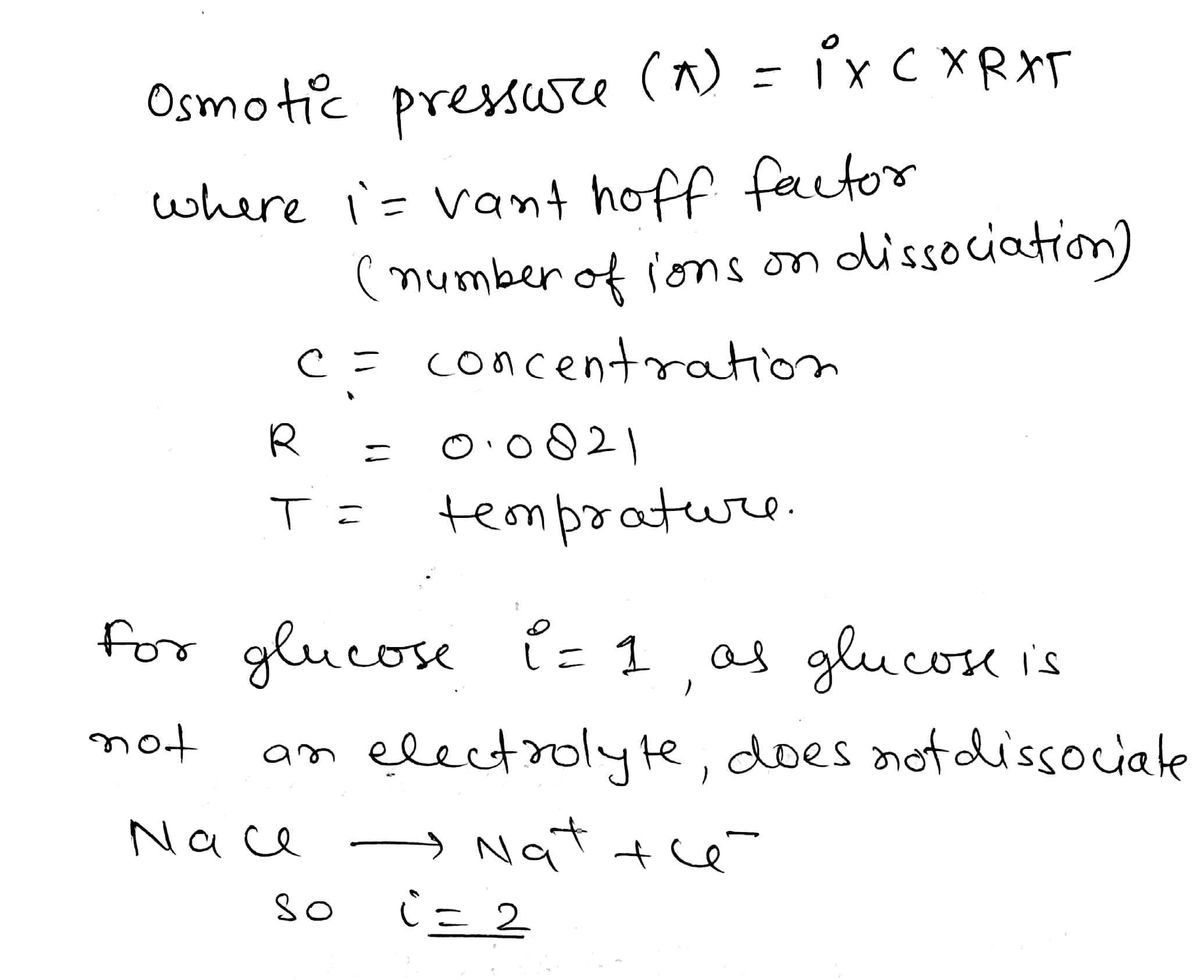**Question:** Label 0.15 M glucose as isotonic, hypotonic, or hypertonic in comparison to 0.9% NaCl (0.15 M NaCl). Click in the answer box to display choices. **Answer Box:** - **(select)** **Explanation:** You are asked to determine whether a solution of 0.15 M glucose is isotonic, hypotonic, or hypertonic relative to a solution of 0.9% NaCl (0.15 M NaCl). In this context: - **Isotonic** means the solutions have the same osmotic pressure. - **Hypotonic** means the glucose solution has a lower osmotic pressure than the NaCl solution. - **Hypertonic** means the glucose solution has a higher osmotic pressure than the NaCl solution. The comparison is based on molarity and the nature of the solutes. Both solutions have the same molarity, but since NaCl dissociates into ions, it has a greater osmotic effect. Therefore, the glucose solution is likely hypotonic relative to the NaCl solution.
**Question:** Label 0.15 M glucose as isotonic, hypotonic, or hypertonic in comparison to 0.9% NaCl (0.15 M NaCl). Click in the answer box to display choices. **Answer Box:** - **(select)** **Explanation:** You are asked to determine whether a solution of 0.15 M glucose is isotonic, hypotonic, or hypertonic relative to a solution of 0.9% NaCl (0.15 M NaCl). In this context: - **Isotonic** means the solutions have the same osmotic pressure. - **Hypotonic** means the glucose solution has a lower osmotic pressure than the NaCl solution. - **Hypertonic** means the glucose solution has a higher osmotic pressure than the NaCl solution. The comparison is based on molarity and the nature of the solutes. Both solutions have the same molarity, but since NaCl dissociates into ions, it has a greater osmotic effect. Therefore, the glucose solution is likely hypotonic relative to the NaCl solution.
Chemistry
10th Edition
ISBN:9781305957404
Author:Steven S. Zumdahl, Susan A. Zumdahl, Donald J. DeCoste
Publisher:Steven S. Zumdahl, Susan A. Zumdahl, Donald J. DeCoste
Chapter1: Chemical Foundations
Section: Chapter Questions
Problem 1RQ: Define and explain the differences between the following terms. a. law and theory b. theory and...
Related questions
Question

Transcribed Image Text:**Question:**
Label 0.15 M glucose as isotonic, hypotonic, or hypertonic in comparison to 0.9% NaCl (0.15 M NaCl). Click in the answer box to display choices.
**Answer Box:**
- **(select)**
**Explanation:**
You are asked to determine whether a solution of 0.15 M glucose is isotonic, hypotonic, or hypertonic relative to a solution of 0.9% NaCl (0.15 M NaCl).
In this context:
- **Isotonic** means the solutions have the same osmotic pressure.
- **Hypotonic** means the glucose solution has a lower osmotic pressure than the NaCl solution.
- **Hypertonic** means the glucose solution has a higher osmotic pressure than the NaCl solution.
The comparison is based on molarity and the nature of the solutes. Both solutions have the same molarity, but since NaCl dissociates into ions, it has a greater osmotic effect. Therefore, the glucose solution is likely hypotonic relative to the NaCl solution.
Expert Solution
Step 1

Step by step
Solved in 2 steps with 2 images

Recommended textbooks for you

Chemistry
Chemistry
ISBN:
9781305957404
Author:
Steven S. Zumdahl, Susan A. Zumdahl, Donald J. DeCoste
Publisher:
Cengage Learning

Chemistry
Chemistry
ISBN:
9781259911156
Author:
Raymond Chang Dr., Jason Overby Professor
Publisher:
McGraw-Hill Education

Principles of Instrumental Analysis
Chemistry
ISBN:
9781305577213
Author:
Douglas A. Skoog, F. James Holler, Stanley R. Crouch
Publisher:
Cengage Learning

Chemistry
Chemistry
ISBN:
9781305957404
Author:
Steven S. Zumdahl, Susan A. Zumdahl, Donald J. DeCoste
Publisher:
Cengage Learning

Chemistry
Chemistry
ISBN:
9781259911156
Author:
Raymond Chang Dr., Jason Overby Professor
Publisher:
McGraw-Hill Education

Principles of Instrumental Analysis
Chemistry
ISBN:
9781305577213
Author:
Douglas A. Skoog, F. James Holler, Stanley R. Crouch
Publisher:
Cengage Learning

Organic Chemistry
Chemistry
ISBN:
9780078021558
Author:
Janice Gorzynski Smith Dr.
Publisher:
McGraw-Hill Education

Chemistry: Principles and Reactions
Chemistry
ISBN:
9781305079373
Author:
William L. Masterton, Cecile N. Hurley
Publisher:
Cengage Learning

Elementary Principles of Chemical Processes, Bind…
Chemistry
ISBN:
9781118431221
Author:
Richard M. Felder, Ronald W. Rousseau, Lisa G. Bullard
Publisher:
WILEY